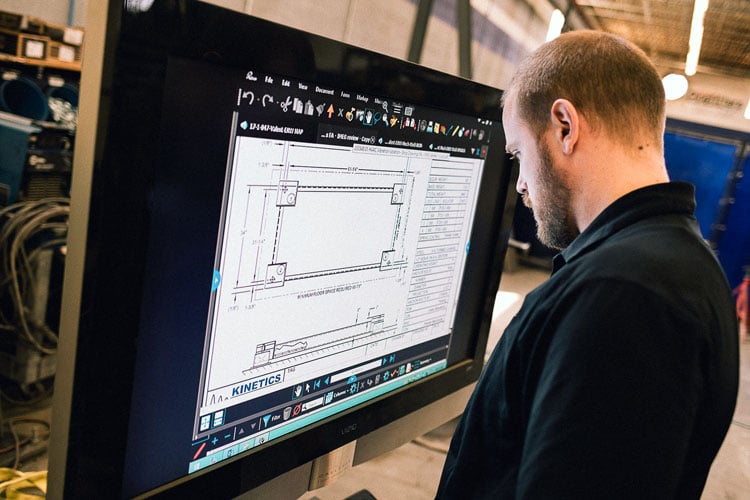You’re a small- to medium-sized business. How much technology do you need? How do you know what technologies to implement? Will going digital help your business? StrXur looks at these questions from the SMB perspective.
The construction industry is booming with technological advancements, from project management and design software to data-integrated machines and hardware. It’s enough to give any firm owner pause as purchasing, implementing and executing project delivery with new technologies—in an industry that doesn’t really have time for R&D—makes integrating tech a daunting task. More importantly, who on your staff can understand and oversee which technologies would be the most beneficial for your size and style of business?
The IT factor
According to the 2017 JBKnowledge Construction Technology report, 49% of all surveyed firms reported having a dedicated IT department, while the rest either outsource IT completely or have dedicated employees that run IT-related tasks—in addition to their actual job responsibilities—simply because they’re tech savvy. How does the SMB factor into these numbers? According to the study, a $20 million annual sales volume seems to be the threshold between companies that have a dedicated IT team and companies that don’t. Does that mean SMBs don’t need IT or that SMBs aren’t taking tech implementation seriously? The short answer to both of those questions is “not necessarily.” It comes down to resources and need based on the business.
Case in point, Solid Earth Civil Constructors out of Pueblo, Colorado. Recently named 2018 Contractor of the Year by Equipment World magazine, Solid Earth was told point-blank by large potential client Trammell Crow that if they did not submit digital bids, they could not work with them. The software the firm recommended was Bluebeam Revu, yet Solid Earth had no IT manager to dedicate to proper implementation and use of the software. Co-Founder Don Peters turned to Field Operator and Foreman Drake Carter and immediately redefined his role to the IT sector for the company. “Don said, ‘Drake, you’re no longer in the field; you’re going to be a digital project manager and an estimator.’” With four years of CAD experience, Carter fit the bill for what the firm was looking for, and with only 15 core employees, transferring one from the field was a gamble that had to pay off. It did. Working with Revu to submit bids to companies like Kiewit and Bechtel allowed the firm to triple their submittals. Now, the award-winning company has more job opportunities than staff to execute them.
Allowing Carter to limit his responsibilities to focus on digital technology has given Solid Earth the versatility to incorporate digital solutions quickly and effectively, moving the needle on their bottom line. An IT “department” can be just one person depending on an SMB’s needs, so understanding the scope is the key to deciding how staff will be dedicated to overseeing tech.

Making the business case
Going back to the $20 million threshold stat, if the larger companies are dedicating IT to tech implementation, it means that they are using the tech in a pervasive enough way to warrant putting people in charge of maintaining and implementing it. This would also indicate that smaller companies that work with larger companies on projects might benefit from being more technologically savvy—especially in the realm of project communication and delivery. Being able to prove that communication exchange can be detailed, organized and smooth across software and hardware platforms is becoming an advantage to winning work for today’s SMBs.
Based out of Addison, Illinois, Premier Mechanical is an SMB specializing in full-service mechanical contracting services that has served Chicago and the surrounding areas for nearly 25 years. Premier Mechanical Director of Business Development Andy Hubner explained why taking a VDC approach has provided an advantage for the firm. “We hear that a lot, ‘Oh, you guys are spending a lot of money on technology. You guys are investing all this time and you’re just buying toys.’ Truthfully, these are all huge beneficial products for us and this seamless digital communication is allowing us to compete in a market with competitors that are literally four to 10 times our size, but we can still offer the same level of product, if not a higher-quality level of product, through these types of software.” The firm uses the 3D PDF capabilities of Revu to submit bids, and Hubner has seen this tool become a value-add for clients. “Bluebeam has acted as a sales resource in the estimating department for a design-build job because it allows us to show a marked-up drawing with specific equipment manufacturers, model numbers and sizes, etc. The traditional method of going to market is just using a Microsoft Word narrative describing the system that you’re giving the owner. Instead, we’re actually giving the owner a document that is marked up, showing them clearly what they’re getting in certain areas, which is allowing us to be bid level against our competitors, so we can turn over more work. We take that 3D estimate, convert it into a 3D PDF and implement that into our actual sales presentations. This has been so successful that not only are we using it in our own sales presentations, we’re having customers now say, ‘Hey, can I get a 3D PDF for my sales presentation?’ So, my customers are even using my information to help them sell their work. That makes me look like a more intelligent contractor and somebody that they want to use as an ally and partner with.” The digital bid submissions using the 3D PDF and Studio features in Revu recently served as a catalyst for the firm to win its highest paying project in company history.
The GC/sub influence
As is the case above with Trammell Crow and Solid Earth, many project lead contractors are using VDC technology throughout the project build process, compelling subcontractors and specialty contractors to use digital project communication tools prior to working the job. Barton Malow, lead GC for the Daytona Rising project, which rebuilt the Daytona International Speedway, not only mandated that subcontractors use Revu for project communication and workflows, they also trained them on the software. Project Manager Jose Sandoval elaborated, “Our agreement for this project was that every subcontractor would be required to use Bluebeam. When I came back after my master’s, I had to train every one of the subs that we were dealing with. We had a two-hour session on how to use Bluebeam and we covered everything from doing a markup to creating a Studio Session. If they were interested, we would show them a little bit of estimating, how to do your markups and print them, how to do a takeoff, but only if they were interested, and most of them were very interested because Bluebeam makes communicating project information pretty simple.” Sandoval also held internal training for Barton Malow’s own employees so that they could use Revu to work with the subcontractors.
Owner requirements
Not only is the industry abuzz with technological advancements and virtual design and construction, even owners are starting to get into the act. Barton Malow’s Daytona Rising project underscores the value add for companies using technology to win the bids as a project lead. Bruce Rein, the International Speedway Corporation owner’s representative for the Daytona Rising project, outlines the importance of VDC from an owner’s perspective. “When we first started this project, or even the concept of this project, we interviewed three different companies. They all brought something a little bit different to the table. And one thing that kind of made Barton Marlow stand out was the idea of technology, and how they could use that to understand the project, to understand the existing structure, and how they could bring a lot of visual aids, so we can understand how they were going to build the project, how they were going to use the structure to get the correct sightlines. And those are the things that, you know, from an owner’s perspective, and some of the other people, you know, executives, they need to understand that they need technology. They need visual aids to understand what’s really there. And that’s what I think [Barton Malow] was able to bring forward—to be able to see these things, how they would build it.”
In this case, having an owner reward a project lead for technology trickles down to the smaller contractors on the job that will need to use that same technology for project communication with the lead and/or owner.
The future
With owners, large contractors and project leads all using technology for VDC project delivery, it seems inevitable that SMBs would benefit by following suit. While we may be toward the front end of that curve, all evidence points to the fact that the technology is here to stay. How SMBs adapt to this current climate is ultimately in the hands of those business owners, but there are many industry indicators that suggest becoming VDC savvy is the key to the future.















